Understanding the behavior of a child with Autism can be challenging, especially since many behaviors (good and bad) are specific to that child. However, when disaster strikes, here are some simple “go-to” solutions that can make a big difference.
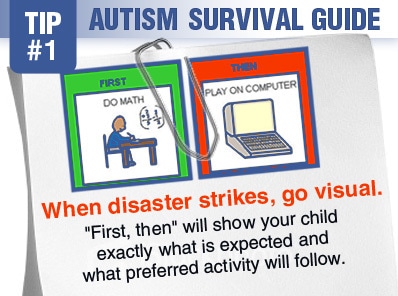 The first thing to do is use visuals. Get your child accustomed to a “first/then” chart. “First, then” will show your child exactly what is expected now and what preferred activity will follow. If he is not familiar with this visual, start using it for everything. Staying consistent with the visuals will help her understand what it means quickly.
The first thing to do is use visuals. Get your child accustomed to a “first/then” chart. “First, then” will show your child exactly what is expected now and what preferred activity will follow. If he is not familiar with this visual, start using it for everything. Staying consistent with the visuals will help her understand what it means quickly.
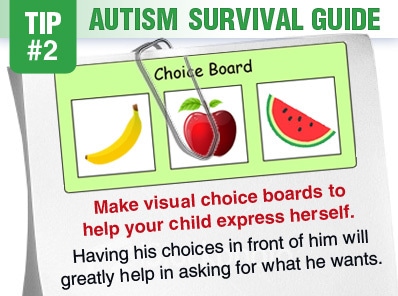 Make visual choice boards to help your child express himself. Having his choices in front of him will greatly help in asking for what he wants. Preferences for toys/food/activities can change quite often for some children.
Make visual choice boards to help your child express himself. Having his choices in front of him will greatly help in asking for what he wants. Preferences for toys/food/activities can change quite often for some children.
Even for a child who is able to talk, when disaster strikes, use visuals! When children are screaming or crying, it is much more difficult to process information auditorily. Looking at a visual of what he needs to do is much more effective than trying to process mom telling him what he needs to do.
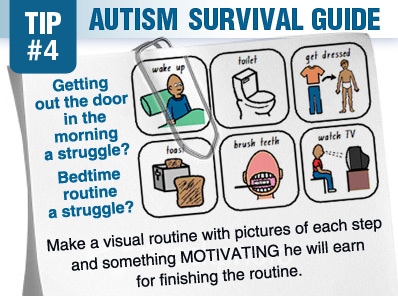 Visuals are a wonderful tool even for everyday routines. If getting out the door in the morning or having a bedtime routine is a struggle, visuals can help greatly! Create a visual routine with pictures of each step and something MOTIVATING she will earn for finishing the routine (kind of like the “first/then” visual). When using toys/food/activities to motivate, remember that preferences can change often, so vary the choices, don’t always assume what she will want.
Visuals are a wonderful tool even for everyday routines. If getting out the door in the morning or having a bedtime routine is a struggle, visuals can help greatly! Create a visual routine with pictures of each step and something MOTIVATING she will earn for finishing the routine (kind of like the “first/then” visual). When using toys/food/activities to motivate, remember that preferences can change often, so vary the choices, don’t always assume what she will want.
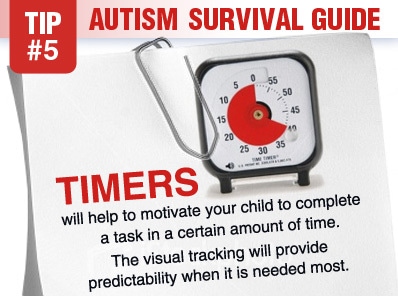 Timers are also a wonderful tool! If your child does not know when he will be done with a task, he is probably going to be less likely to engage in the task and show more inappropriate behaviors. Think about it as if you were told to go to work and your boss told you she would let you know when it is time to leave, but didn’t tell you how many hours you would be there and you did not have a clock. Timers can help motivate your child to complete a task in a certain amount of time and can even be used as a game to “race the clock” to get a task done. The visual tracking will provide predictability when it is needed most.
Timers are also a wonderful tool! If your child does not know when he will be done with a task, he is probably going to be less likely to engage in the task and show more inappropriate behaviors. Think about it as if you were told to go to work and your boss told you she would let you know when it is time to leave, but didn’t tell you how many hours you would be there and you did not have a clock. Timers can help motivate your child to complete a task in a certain amount of time and can even be used as a game to “race the clock” to get a task done. The visual tracking will provide predictability when it is needed most.
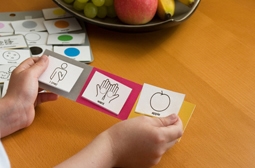 Lastly, when you’re asking a question to a child that requires a vocal response and the child does not say anything, switch your question to where your child can select a response. For example, if you ask the child “What do you want to eat?” and he does not say anything, you can switch to showing him pictures of the food or the items themselves, he can choose from. This way he can still learn how to communicate an answer to you even if he cannot say it yet. This also allows for easier prompting. You can physically prompt him, by taking his hand and pointing to the picture or item he wants. By doing this consistently, in time you can fade the prompting to a hand gesture of you pointing to the pictures and then having him select on his own what he wants. Eventually, when faded correctly, he could start choosing on his own just by showing him the pictures without prompting.
Lastly, when you’re asking a question to a child that requires a vocal response and the child does not say anything, switch your question to where your child can select a response. For example, if you ask the child “What do you want to eat?” and he does not say anything, you can switch to showing him pictures of the food or the items themselves, he can choose from. This way he can still learn how to communicate an answer to you even if he cannot say it yet. This also allows for easier prompting. You can physically prompt him, by taking his hand and pointing to the picture or item he wants. By doing this consistently, in time you can fade the prompting to a hand gesture of you pointing to the pictures and then having him select on his own what he wants. Eventually, when faded correctly, he could start choosing on his own just by showing him the pictures without prompting.
Check out these other blog posts about Autism:

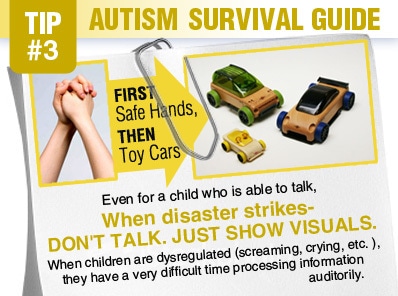
Hello,
Just a short note: Sending you a long overdue “Thank You”. Your information is very helpful.